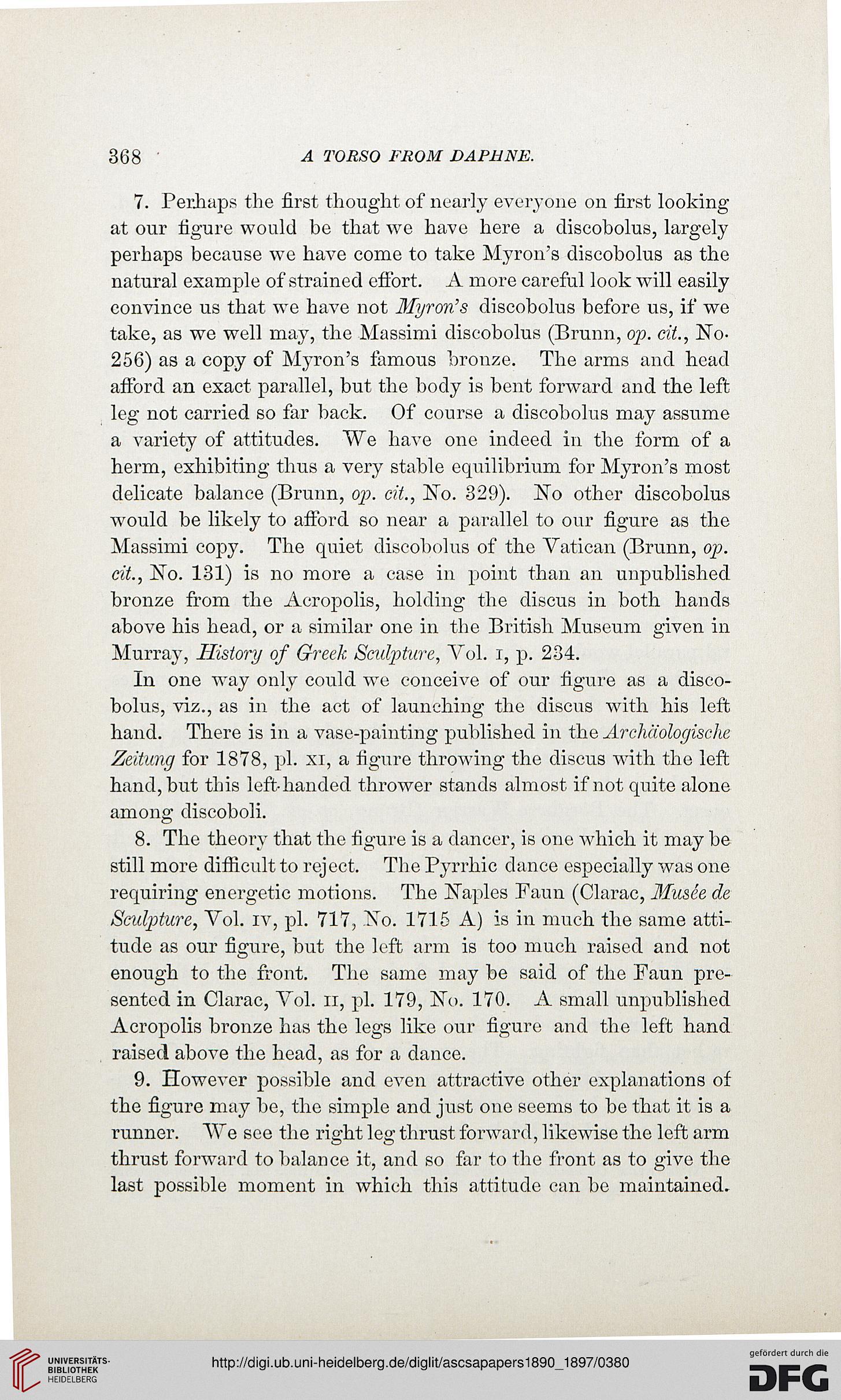368
A TORSO FROM DAPHNE.
7. Perhaps the first thought of nearly everyone on first looking
at our figure would be that we have here a discobolus, largely
perhaps because we have come to take Myron's discobolus as the
natural example of strained effort. A more careful look will easily
convince us that we have not Myron's discobolus before us, if we
take, as we well may, the Massimi discobolus (Brunn, op. cit, No-
256) as a copy of Myron's famous bronze. The arms and head
afford an exact parallel, but the body is bent forward and the left
leg not carried so far back. Of course a discobolus may assume
a variety of attitudes. We have one indeed in the form of a
herm, exhibiting thus a very stable equilibrium for Myron's most
delicate balance (Brunn, op. cit., No. 329). No other discobolus
would be likely to afford so near a parallel to our figure as the
Massimi copy. The quiet discobolus of the Vatican (Brunn, op.
cit., No. 131) is no more a case in point than an unpublished
bronze from the Acropolis, holding the discus in both hands
above his head, or a similar one in the British Museum given in
Murray, History of Greek Sculpture, Vol. i, p. 234.
In one way only could we conceive of our figure as a disco-
bolus, viz., as in the act of launching the discus with his left
hand. There is in a vase-painting published in the Archciologische
Zeitung for 1878, pi. xi, a figure throwing the discus with the left
hand, but this left handed thrower stands almost if not quite alone
among discoboli.
8. The theory that the figure is a dancer, is one which it may be
still more difficult to reject. The Pyrrhic dance especially was one
requiring energetic motions. The Naples Faun (Clarac, Musee de
Sculpture, Vol. iv, pi. 717, No. 1715 A) is in much the same atti-
tude as our figure, but the left arm is too much raised and not
enough to the front. The same may be said of the Faun pre-
sented in Clarac, Vol. n, pi. 179, No. 170. A small unpublished
Acropolis bronze has the legs like our figure and the left hand
raised above the head, as for a dance.
9. However possible and even attractive other explanations of
the figure may be, the simple and just one seems to be that it is a
runner. We see the right leg thrust forward, likewise the left arm
thrust forward to balance it, and so far to the front as to give the
last possible moment in which this attitude can be maintained.
A TORSO FROM DAPHNE.
7. Perhaps the first thought of nearly everyone on first looking
at our figure would be that we have here a discobolus, largely
perhaps because we have come to take Myron's discobolus as the
natural example of strained effort. A more careful look will easily
convince us that we have not Myron's discobolus before us, if we
take, as we well may, the Massimi discobolus (Brunn, op. cit, No-
256) as a copy of Myron's famous bronze. The arms and head
afford an exact parallel, but the body is bent forward and the left
leg not carried so far back. Of course a discobolus may assume
a variety of attitudes. We have one indeed in the form of a
herm, exhibiting thus a very stable equilibrium for Myron's most
delicate balance (Brunn, op. cit., No. 329). No other discobolus
would be likely to afford so near a parallel to our figure as the
Massimi copy. The quiet discobolus of the Vatican (Brunn, op.
cit., No. 131) is no more a case in point than an unpublished
bronze from the Acropolis, holding the discus in both hands
above his head, or a similar one in the British Museum given in
Murray, History of Greek Sculpture, Vol. i, p. 234.
In one way only could we conceive of our figure as a disco-
bolus, viz., as in the act of launching the discus with his left
hand. There is in a vase-painting published in the Archciologische
Zeitung for 1878, pi. xi, a figure throwing the discus with the left
hand, but this left handed thrower stands almost if not quite alone
among discoboli.
8. The theory that the figure is a dancer, is one which it may be
still more difficult to reject. The Pyrrhic dance especially was one
requiring energetic motions. The Naples Faun (Clarac, Musee de
Sculpture, Vol. iv, pi. 717, No. 1715 A) is in much the same atti-
tude as our figure, but the left arm is too much raised and not
enough to the front. The same may be said of the Faun pre-
sented in Clarac, Vol. n, pi. 179, No. 170. A small unpublished
Acropolis bronze has the legs like our figure and the left hand
raised above the head, as for a dance.
9. However possible and even attractive other explanations of
the figure may be, the simple and just one seems to be that it is a
runner. We see the right leg thrust forward, likewise the left arm
thrust forward to balance it, and so far to the front as to give the
last possible moment in which this attitude can be maintained.





